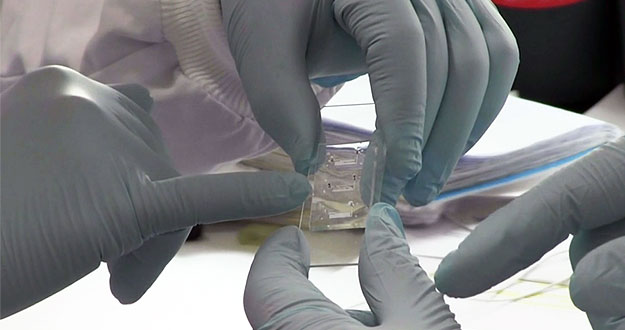Researchers from two Spanish groups have created a first functional model of spleen in 3D, built in a chip capable of acting as this organ. I mean, you can filter the red blood cells.

The spleen built in a chip, by IBEC and CRESIB
The model, created by scientists at the Institute for Bioengineering of Catalonia (IBEC) and the Research Center ISGlobal, CRESIB, represents a breakthrough in the field of Microengineering for 'organs-in-a-chip', as reported by the IBEC in a note.
The journal Lab on a Chip published, this month, the results of the research, revealing that have been recreated, on microscale, the physical properties and the hydrodynamic forces of the functional unit of the red pulp of the spleen.
The resulting device can be used to identify potential drugs against malaria and other blood diseases.
The Doctors Josep Samitier, director of IBEC, and Hernando del Portillo, ICREA Professor CRESIB, have been those who have devised the 'spleen-in-a-chip'. Samitier studying the rheological properties (these properties study the behavior of fluids under mechanical load) of blood, including that parasitized by malaria, to develop diagnostic systems. For his part, the Dr. del Portillo has been studying the role of the spleen in malaria.
"Because of the ethical and technological of studying the human spleen, known as the 'black box' of the abdominal cavity, there has been very little progress in its study", says Portillo. To break this barrier, began a collaboration to develop a model of human spleen-in-a-chip through the EXPLORE project.
"The spleen fluidic system is very complex and evolutionarily adapted to filter and selectively destroy old red blood cells, micro-organisms and parasitized red blood cells by malaria", said Dr. Antoni Homs, IBEC researcher and co-author of the study.
"The spleen filters blood using a single method, making 'microcircular' through filtration beds formed by the red pulp of the spleen in a special compartment where the hematocrit [the percentage of red blood cells] is increased. So, the specialized macrophages can recognize and destroy the red blood cells sick", continues Homs.
In addition, the blood can travel in this compartment only in one direction through interendothelial slits before reaching the circulatory system, which represents a second rigorous test to ensure the removal of old or diseased cells, says the IBEC.
The researchers at these centers have imitated these two control conditions in its micro size platform to simulate blood microcirculation through two main channels (one slow and one fast) designed to divide the flow.
In the "slow" channel, the blood flows through an array of pillars, simulating the real environment, where the hematocrit increases and the 'sick' blood is destroyed.
The device has been tested on healthy human red blood cells and in infected people with malaria, work mostly done by predoctoral researchers Luis G. Rigat-Brugarolas (IBEC) and Aleix Elizalde-Torrent (CRESIB / ISGlobal), also co-authors of this work.
"Our device will facilitate the study of the function of the spleen in malaria and might even provide a flexible platform for the detection of potential drugs against this and other hematologic diseases", says Portillo.
"Research in organ-in-a-chip integrated microfluidic cell system is still in its infancy, but offers tremendous prospects for the future of drug trials for different diseases", specifies Samitier.
These devices 3D, which mimicking the interrelationships tissue-tissue and the microenvironments only seen in living bodies, allows a new perception of the diseases that can not be easily obtained with conventional animal studies, which are costly and time consuming. Also gives way to human-related outcomes that animal models can not predict.
Well. I think this is a very interesting discovery. I hope that it is good for many people, all over the world.
Till soon, kind regards,
Luis.
Sponsored by Costaluz Lawyers.
Please click down here:
